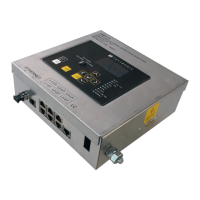63
SME2-IS - Manual - 06- 2021
MEASUREMENTS, LOGICAL STATES AND COUNTERS
• Activation of a logical input set to Fault trigger
The relay saves the last 20 faults in cyclical FIFO memory (First In, First Out).
[1][2]
The following information is automatically logged:
• Fault counter
[3]
0...19
• Date and time
• Cause of fault (tripped threshold)
• Phase currents I
L1r
, I
L2r
, I
L3r
• Phase voltages U
L1r
, U
L2r
, U
L3r
• Phase-to-phase voltages U
12r
, U
23r
, U
31r
• Residual current I
Er
• Residual voltage U
Er
• Phase shift Phi
Er
• Phase shift PhL
1r
, PhL
2r
PhL
3r
• Phase shift Alpha
1r
, Alpha
2r
Alpha
3r
• Active power P
r
• Reactive power Q
r
• Input status
• Output status
• Information about the cause of the fault (faulty phase)
The diagnostics function tripped by higher level faults disables all protection functions and switches
all output relays to non-actuated:
• relay in standby if the output relays are working in DE-ENERGIZED mode (contact status as
shown in the diagrams)
• relay in activated if the output relays are working in ENERZISED mode (contact status opposite
to that shown in the diagrams)
Event logging - SER
Logging is activated by at least one of the following causes:
• Start or tripping of an enabled protection or control function
• Activation of a logical input (OFF-ON or ON-OFF)
• Auxiliary power ON or OFF
The relay saves the last 300 faults in cyclical FIFO memory (First In, First Out).
[2][4]
The following information is automatically logged:
• Event counter
[5]
• Date and time
• Cause of event (logical input/protection or control function trip/changed calibration).
Measurement logging
• Date and time
• Active power Pm
• Reactive power Qm
• Voltage V
m
DFR
The relay integrates a digital fault recorder function
[6]
using the COMTRADE format; the measure-
ments are sampled and saved in a cyclic memory buffer.
This information is a fundamental aid to analysing the electrical system, both when faults occur and
during commissioning.
The logs are generated automatically and archived in sequential order until the available memory is
lled, after which an area of memory containing one or more less recent logs is overwritten.
An example procedure using the relay's disturbance recording function is given in the description
of the Thyvisor software.
The DFR function requires the following settings to be made:
• Enable an alarm when 80% of the buffer is full. The logs are generated automatically and archived
in sequential order until the available memory is lled; the alarm noties the user that it is time to
download the data from the relay's memory
[7]
so that the memory can be deleted without losing
less recent logs which will be overwritten by subsequent logs.
Note 1 The data for the most recent fault is saved as Fault 0, while that for the least recent fault is saved as Fault 19
Note 2 The data is saved to non volatile memory and is kept even when power is absent
Note 3 The counter is incremented at each fault; it can be reset using Thyvisor
Note 4 The data for the most recent fault is saved as Event 0, while that for the least recent fault is saved as Event 299
Note 5 The counter is incremented at each event; it can be reset using Thyvisor
Nota 6 The digital fault recorder function requires a license - contact Thytronic to license it.
Note 4 The data is saved to non volatile memory and is kept even when auxiliary power is absent

